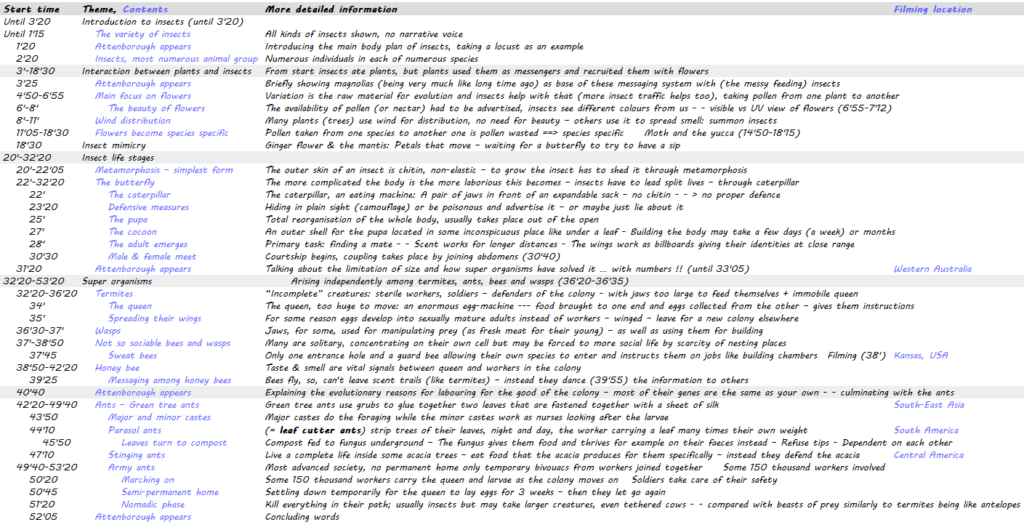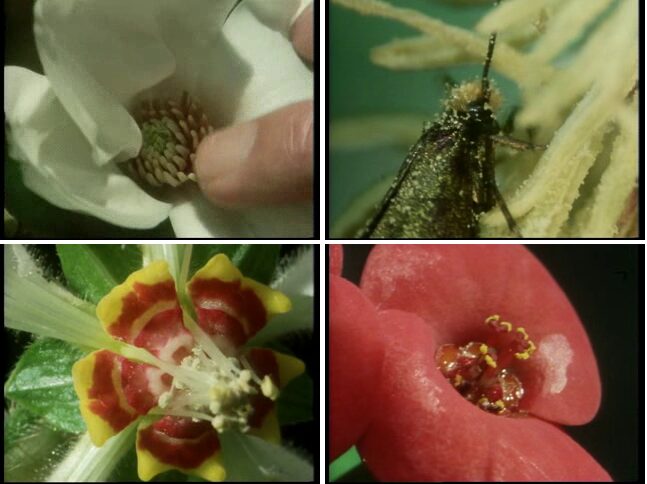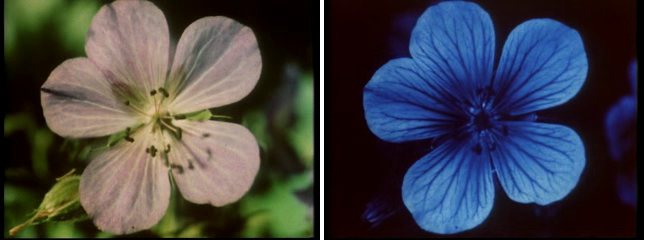Original air date: 6 February 1979
This episode is exclusively about flowers and insects. It is constructed of 3 main parts as shown in the outline below.

As the outline shows it starts, somewhat thematically, with the plants (naturally shown in green) and their relationship with insects. This is followed by insects (mainly larvae) mimicking plants to hide in plain sight and then changing to adults like butterflies. This can also be seen as a step towards being less dependent on the plants. In blue the final part of the episode is about super organisms.
The outline above shows a graphical timeline of the programme, a more detailed text version is below

Selected material
Interdependence of flowering plants and insects (3’40-5’40)

The first snapshot (top left) shows Attenborough pointing at so-called stamens that hold pollen meant to fertilise another flower (a male fertilising a female). The pollen are food to the insects and if they ate all the pollen it wouldn’t help the flowers, but the plants produce too many pollen for the insects to eat all of them and the insects are messy eaters, get pollen all over them (top right). Then these insects go the the next plant and the pollen rub onto those, fertilisation accomplished! Some plants even added nectar to the rewards. Such rewards had to be advertised (bottom row). These flowers look quite beautiful to us but their beauty is not meant for us, they are meant for insects, who see them quite differently from us (comparison below).
Our “normal” view vs insect UV view (6’50-7’12)

Normal view of a flower (left) and the way insects see the flower (right)
Showing (through UV filters) the way insects view flowers differently from us. Even relatively drab flower viewed in with a UV filter shows very clear signs of what the insects are meant to do. “… like instructions on an airfield”.
An impressive collection of such images can be found here.
The insect body: size limitation … and their solution (31’45-32’35)

One of the main limitations to the insect body plan being that they breathe through holes along their flanks (left). These holes lead to branches that extend throughout their body and feed it with oxygen. It works with diffusion and only work over short distances. Longer tubes are less efficient so there are limits to how large an insect can become. There are, therefore, no moths the size of large birds. But they have solved this problem in a most ingenious way; with numbers. A termite hill (right) may contain a few million individuals. Their grazing of the surroundings is similar to that of gazelle. Like Attenborough pointed out; if the termites graze like an antelope then the ants (snapshots below) graze like an apex predator similar to a lion – army ants attacking everything in their path.

Cooperation among ants – and some kind of tool use (starts at 42’35)

Green tree ant workers pull together two sheets of leaves gripping them with their legs and jaws to pull them together (top) and (bottom) use grubs that they squeeze to produce silk to tie them together and then moving them back and forth on the leaves to apply them as tubes of glue (bottom) until they stick together. This looks like highly coordinated team work and tool use. The arrows point at the grubs that may not be obvious otherwise.
Final words:
While Attenborough was watching army ants he spoke the following words (in admiration):
“Man has been doing battle with insects ever since he picked off the first flee and I dare say long before. Today we continue the fight with fire, with radioactivity, with the most lethal poisons that our chemists have been able to device and yet we haven’t managed to exterminate a single species of them”.
Whether Attenborough is right is debatable. Decades earlier the rocky mountain locust had been wiped out, but that was done indirectly* as with most animals of this size. It is true that poisons and other weapons have worked as discussed in the final episode of Living Planet.
*Garcia, M. 2000. “Melanoplus spretus” (On-line), Animal Diversity Web
Filming locations
Western Australia: Talking about termite mounds (32’30-33’30), introducing the term “super-organism”
Southeast Asia: Talking about social society of green tree ants (42’35). Attenborough talks about them and points at the ground where the vegetation is quite different from the next scene (probably the difference between a normal and a close-up sequence. Only during the close-up does he mention the location, possibly because it’s in an entirely different location.
Other filming locations (without Attenborough appearing):
South America: Mention of the parasol ants stripping trees of their leaves (44′)
Central America: Stinging ants living inside thorns of acacia trees (47′). They are fed by the acacia and defend it against any intruder.